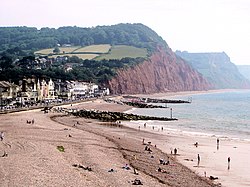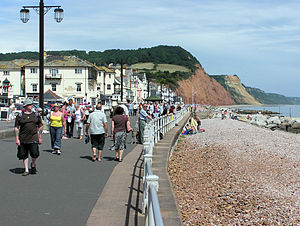Sidmouth
| Sidmouth | |
| Devon | |
|---|---|

| |
| Location | |
| Grid reference: | SY124874 |
| Location: | 50°40’48"N, 3°14’20"W |
| Data | |
| Population: | 14,400 |
| Post town: | Sidmouth |
| Postcode: | EX10 |
| Dialling code: | 01395 |
| Local Government | |
| Council: | East Devon |
| Parliamentary constituency: |
East Devon |
Sidmouth is a seaside resort town standing on the English Channel coast in Devon. It is 15 miles southeast of the county town, Exeter, and close by the Dorset border. Sidmouth had a population of about 15,000 in 2001, of whom 40% were over 65.
Sidmouth is a tourist resort and a gateway to the Jurassic Coast World Heritage Site. A large part of it has been designated a conservation area.
Contents
History
Sidmouth appeared in the Domesday Book as Sedemuda. Like many such settlements, it was originally a fishing village. Although attempts have been made to construct a harbour, none has succeeded. A lack of shelter in the bay prevented growth as a port.[1]
Sidmouth remained a village until the vogue for coastal resorts grew in the Georgian and Victorian periods of the 18th and 19th centuries. The numerous fine Georgian and Regency villas and mansions are now mostly hotels.
In 1819, George III's son Edward, Duke of Kent, his wife, and baby daughter, the future Queen Victoria, came to stay at Woolbrook Glen for a few weeks. In less than a month he had died from an illness. The house later became the Royal Glen Hotel; a plaque on an exterior wall records the visit.
In 1874, Sidmouth was connected to the railway network by a branch line from Sidmouth Junction. This was dismantled in 1967 as part of the Beeching Axe.
In 2008, Canadian millionaire, Keith Owen, who had vacationed in the town and planned to retire there, bequeathed the community's civic society, Sid Vale Association, about £1.5 million upon learning that he had only weeks to live due to lung cancer. The bequest is to be used as a capital fund to generate an annual interest dividend of around £60,000 for community projects.[2]
Geography
Sidmouth lies at the mouth of the River Sid in a valley between Peak Hill to the west and Salcombe Hill to the east. It is surrounded by the East Devon Area of Outstanding Natural Beauty and is on the Jurassic Coast, a World Heritage Site, and the South West Coast Path. The red-coloured rock indicates the arid conditions of the Triassic geological period.
Erosion remains a serious concern east of the mouth of the Sid. The cliffs have been heavily eroded, threatening homes and the coastal footpath.[3][4]
The wide esplanade has been a prominent feature since the Regency perios. A series of southwesterly storms in the early 1990s washed away much of the shingle beach protecting the masonry. A series of artificial rock islands was constructed to protect the sea front, and tons of pebbles were trucked in to replace the beach.[5]
Churches
The parish church is dedicated to St Giles & St Nicholas; it was rebuilt in 1860. Of the mediæval structure only the 15th century tower was retained; the architect was William White. Oddments of Norman and later stonework were included in the rebuilding. Features of interest include the reredos by S S Teulon and the Duke of Kent Memorial Window which Queen Victoria gave in 1867. Parts of the original fabric such as the windows were reused by the historian Peter Orlando Hutchinson in building a folly adjoining his house. He was also responsible for saving the stained glass in the vestry.[6][7] The folly is the Old Chancel in Coburg Terrace which was started by Hutchinson in 1859, in protest over the destruction of the original church fabric during rebuilding.
The church of All Saints, also Church of England was built in 1837 in the Early English style with lancet windows and "oddly clumsy" pinnacles.[8] There were also
Unitarian, Wesleyan (later Methodist) and Congregational chapels were built in Sidmouth at its height; the Unitarian chapel was built as a Presbyterian chapel in the 17th century and the Wesleyan and Congregational chapels in 1837 and 1846 respectively.[9]
Sights about the town
The Esplanade is the main street down by the front in Sidmouth. At one end are the red cliffs, and at the other is Jacob's Ladder Beach. Peak Hill can be seen in the distance. Along the street are many shops and cafes, and it is the ideal place to sit in a deckchair to watch the sea.
Jacob's Ladder is popular with tourists; it is a simple series of wooden steps leading up to a viewing point for Jacob's Ladder Beach and the entrance to Connaught Gardens. The steps are next to Jacob's Ladder beach, another location under the red cliffs of the Jurassic Coast, which is linked to the beach in Sidmouth bay. Below Jacob's Ladder is a path linking The Esplanade to the steps and the beach. An alternative route up to Connaught Gardens is a steep path, which (at the top) ends with a grassy hill to the left and a different entrance to Connaught Gardens to the right.
The Victoria Hotel is a prestigious hotel overlooking Sidmouth bay, with grounds covering five acres of land. It is a four star luxury hotel which is just a short stroll from the centre of town. It is situated next to the Royal Glen Hotel which accommodated Queen Victoria when she was young, however it was just a house then.
Connaught Gardens are one of Sidmouth's best features. They date back to around 1820, and they were named after Prince Arthur, Duke of Connaught and Strathearn|, the third son of Queen Victoria. He officially opened the gardens in 1934, when he was aged 84. The gardens were used during the Second World War, a key to protecting the south coast; they provided a wide view of the sea. They are used regularly for entertainment today - in one of the gardens there is a bandstand and a wide, open space facing it. On most weeks during the warm season bands will play.
Peak Hill Slope is a grassy slope up and along Peak Hill can be seen while on The Esplanade. It follows the red cliffs which stand above Jacob's Ladder Beach, and there are benches placed along the edge the whole way up. At the top the view is spectacular - the whole of Sidmouth can be seen, as well as Salcombe Hill in the distance, the Esplanade, the town center, and Connaught Gardens below.
The ford is where the River Sid (which runs through Sidmouth) flows over the road at the end of Mill Street.
The Museum, next to the church, has local memorabilia, historical artefacts, and geological samples.[10]
The Norman Lockyer Observatory and Planetarium is on Salcombe Hill. The facility, completed in 1912, fell into disuse but was saved from demolition by the appeals of enthusiasts to the local council. The observatory now operates as a science education project and is open to the public.[11]
Music
Sidmouth Folk Week is a famous annual folk festival in early August attracting musicians and visitors from around the world. Due to the increased cost of public liability insurance, it became less financially viable over the years and in 2005 the last of the commercial sponsors, essential for its existence, pulled out. To continue the tradition, individuals grouped together to form Sidmouth FolkWeek productions, a limited company. Since the change of format, the event has been held on a smaller scale, with no arena at the Knowle, though marquees are still erected in the Blackmore Gardens and The Ham at the eastern end of the town.
The Sidmouth Town Band, a brass band, play a series of concerts in the Connaught Gardens during the summer each Sunday at 8 in the evening. This tradition has been maintained since it was formed in the 1860s and runs from late May until early September.
Literary associations
Sidmouth has featured in various literary works, for example as "Stymouth" in Beatrix Potter's children's story The Tale of Little Pig Robinson (1930) in which the author included views of the beach and other parts of the Devon countryside. In Thomas Hardy's Wessex it is the inspiration for "Idmouth". "Baymouth" in William Makepeace Thackeray's Pendennis, and "Spudmouth" in the The Merry Adventures of Robin Hood by Howard Pyle, are both based on the town.
Sidmouth has been the setting for several television productions.
It was a favourite spot for Sir John Betjeman. He chose it as the subject of the first programme of the television series Television|John Betjeman In The West Country that he wrote and presented in 1962. The script takes the form of an extended poem and was republished in 2000 as a short book.[12]
Miscellany
The Sidmouth Herald is the local newspaper.
The Manor Pavilion houses an arts centre and a theatre that hosts both amateur and professional productions.[13] There is also the Radway Cinema.[14]
Sidmouth has been a frequent winner of Britain in Bloom awards. Most recently it won the Small Town category in 2001 and the Coastal Resort category in 2005.
Economy
The principal revenue is from tourism. Sidmouth is a retirement location, so pensioner spending is another source of income.
The largest employer is the local council, whose headquarters are at the former Knowle Hotel. There is a large independent department store, Fields of Sidmouth, which has been on the same site for over 200 years. There are pubs, restaurants, coffee houses, and tea rooms; also an indoor swimming pool, a sports hall at the leisure centre, and a golf course.
Outside links
- Sidmouth Town Council
- Rock fall at Pennington Point near Sidmouth February 2009 British Geological Survey
References
- ↑ The Sidmouth Harbour Company of 1836
- ↑ Daily Mail
- ↑ "Devon County Council - Market Town Focus - Sidmouth". Devon County Council. http://www.devon.gov.uk/index/councildemocracy/neighbourhoods-villages/market-town-focus/sidmouth.htm. Retrieved 2009-10-02.
- ↑ "Protect Alma Bridge plea from Sidmouth Chamber of Commerce". Sidmouth Herald. 2009-08-02.
- ↑ Simm, Jonathan; Cruickshank, Ian (1998). Construction Risk in Coastal Engineering. London: Thomas Telford Publishing. ISBN 0-7277-2686-2.
- ↑ Mee, Arthur (1938) Devon. (The King's England.) London: Hodder & Stoughton; p. 390
- ↑ Pevsner, N. (1952) South Devon. Harmondsworth: Penguin; p. 262
- ↑ Pevsner, N. (1952) South Devon. Harmondsworth: Penguin; p. 263
- ↑ White's Devonshire Directory of 1850; Sidmouth in Genuki; retrieved 2012-08-24}}
- ↑ Sidmouth Museum
- ↑ Lockyer Observatory and Planetarium
- ↑ Betjeman, John (2000). Still Sidmouth: the Lost Poem. Ottery St Mary: Peretti Publishing. ISBN 978-0-906038-09-3.
- ↑ Manor Pavilion - Sidmouth
- ↑ Scott Cinemas: Sidmouth - the Radway Cinema



